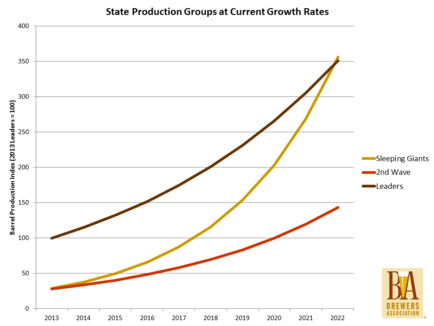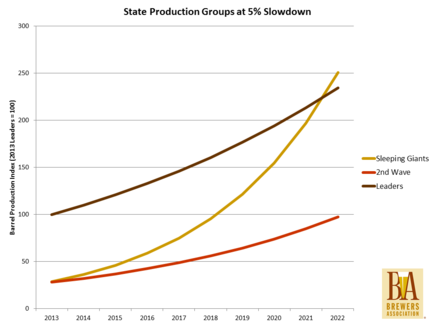In part two of my focus on the states series I want to look at state growth. Although the national story of 18% production volume growth is an interesting one, there are plenty of exciting sub-stories at the state level. First, let’s start with the basics. What parts of the country are growing the fastest? Guesses?
The heatmap below shows state-by-state production volume growth rates in 2013. Maybe not what you expected? West Virginia, Alabama, North Dakota?! Perhaps not the first states that come to mind when you think of craft brewing (though there are some excellent breweries in each).

The explanation stems from the fact that each of the aforementioned states are growing off small bases, and so even if they aren’t adding the most new barrels in absolute terms, their percentage growth rates are still quite impressive. For me, this begs a couple of follow-up questions.
- How much faster are these “laggard” states growing from the leaders?
- How long will it take them to catch up?
To look at this I broke the country into three categories based on 2012 production per capita data. I found three natural cutting points1:
- The “Leaders”: States with production of 2.5 gallons per 21+ adult and up (12 states)
- The “2nd Wave”: States between 1.5 – 2.5 gallons per 21+ adult (8 states)
- The “Sleeping Giants” (more on the name in a second…): States below 1.5 gallons per 21+ adult (30 states plus D.C.)
Currently, the “Leaders” produce the majority of craft beer in the country (64% of production occurred in those 12 states). But how long will it remain like that? Two things make me think that the production in the other states, particularly in the “Sleeping Giants” is about to explode.
The first is population. Despite only accounting for 18% of craft beer production in 2013, the 30 states at the bottom of the production spectrum currently account for 54% of the U.S. 21+ adult population. That’s over 120 million potential craft beer lovers (the Giant) in states that produce less than one-fifth of the nation’s craft barrels (the Sleeping).
| % of 2013 Craft Production | % of U.S. 21+ Population | |
| Leaders | 64 | 28 |
| 2nd Wave | 18 | 19 |
| The Sleeping Giants | 18 | 54 |
Yes, there are first mover advantages for the leaders, but ‘local’ is a big part of craft’s appeal, and in the long run one would expect geographic production levels to shift toward geographic population.
The second reason is current growth trends. The reason I used 2012 production per capita is so I could compare it to 2013 growth.2 And the differential in growth rates between the categories may surprise you.

*Note: for scale/presentation reasons, one state (a Sleeping Giant state with 400%+ growth was eliminated from this graph)
In 2013, the Leaders averaged slightly below the national average, with 14% production growth. The 2nd Wave states were slightly above the national average with 19% production growth. The Sleeping Giants? 31% production volume growth.
31% growth is pretty incredible. Again, this is on a small base (those states were still under 3 million barrels of collective production in 2013), but it doesn’t take too many years to catch up when you grow 17 percentage points faster than the states you are chasing. How many? Well, if the sleeping giants can keep up that differential, they’ll catch the leaders in absolute production by 2022 and per capita production by 2026. See the graph below for an illustration at current growth rates.

Now, you might be saying: but growth is inevitably going to slow down. True, 18% growth probably can’t last until 2022, but the great catch-up will happen as long as the catch-up states keep growing 17% faster than the leader states, even with an overall slow-down in craft growth. Here’s the same graph as above but with a 5% slowdown in every group (so 9%, 14%, and 26% growth respectively). Again, the catch-up states cross the leaders in 2022 (note: under this scenario, total production is 3.7 times higher than current levels in 2022… this should not be interpreted as a prediction of what will happen. I’ll have more on this in future blog posts).

Now, maybe none of this will occur. Maybe regulatory hurdles in the Sleeping Giants will hold small producers back. Maybe beer lovers in those 30 states won’t support fuller-flavored, locally-produced beers from independent producers. But aren’t those the same things that they said about craft in the first place?
1 You could just as easily do this based on breweries per capita with a fairly similar set of state groups. Since this post is about production, I chose production groupings. 2 I’d argue a lagged measure is better for this. The 2013 groupings show almost exactly the same thing.



 Resource Hub
Resource Hub